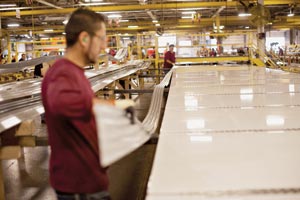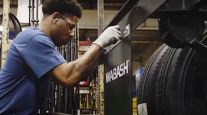Senior Reporter
Trailer Orders Top 35,000

September trailer orders of 35,952 marked the highest total this year, according to ACT Research.
The 12% year-over-year gain was driven by fleets placing orders before production slots were filled, said ACT, which also noted September’s total was 46.6% above August’s level.
“While September’s early kickoff to the fall-winter order season was not particularly surprising, the volumes in dry vans and reefers were a bit more robust than anticipated, up 55% and 47% month-over-month, respectively,” ACT analyst Frank Maly said in a statement.
But it continues to be a tale of two markets, Maly told Transport Topics.
While dry and refrigerated vans are being ordered in large numbers, vocational trailers are lagging due to the decline in the energy sector, he said.
Net orders in the nine-month period stood at 216,457, down from 229,872 in the 2014 period, when trailer orders began to surge, Maly said.
Rhem Wood, an analyst with BB&T Capital Markets, agreed that dry and reefer trailer orders remained strongest and said in a note that liquid tanks were better.
Maly said that at current production rates the industry-average backlogs are seven months on dry van and a little more than that on reefer vans.
“Now, if you are on the tank or bulk side or flatbed side, it’s not quite as robust a number,” he said.
The backlog is 2½ months for flatbeds and 4¼ months for tankers, Maly said.
Dick Giromini, CEO of Wabash National Corp., the nation’s leading trailer maker, said during a third-quarter earnings call the company has a full order book through the fourth quarter and is experiencing seasonally stronger demand than normal for 2016 build slots.
“Longer term, supported by a healthy backlog of $1.1 billion, we believe the demand environment for trailers will remain strong as customer profitability, fleet age and regulatory compliance requirements all support an extended trailer cycle,” Giromini said.
Several other trailer makers were unavailable or declined to comment for this article.
Michael Baudendistel, an analyst with Stifel, Nicolaus & Co., said in an investor’s note that Wabash opened its order book “early this year to meet the demands of large fleet customers that wished to get their orders in earlier than the typical seasonal order season.”
Baudendistel noted that Wabash’s backlog stood at $794 million at the end of the year-ago period.
Maly explained that order pattern continues a trend over the past couple of years.
“What normally was a stronger fourth quarter has been getting pulled forward into the year, earlier and earlier,” Maly said. “Almost late summer, depending on how you want to label it.”
He said that shift helped generate the “massive October” last year when orders climbed to 47,512 units.
“And I think that is what helped generate this strong September. [Large fleets] are encouraged to make those commitments earlier when the backlogs are longer,” in line with their internal needs and plans, Maly said.
Meanwhile, research firm FTR said net orders were significantly above expectations at 34,700.
FTR Vice President Don Ake said in a release, “The fall order season starts off with a bang. The dry van and refrigerated van segments are running at record levels and show no signs of slowing down at this point. However, based on what is happening on the truck side, the trailer market must ease up at some point.”
Ake added that the trailer market is in great shape heading into 2016. “This is a fantastic start to the traditional order cycle, and it is consistent with our forecast for a soft landing next year.”
Wood said he believes the 2015 trailer industry forecasts of 308,500 units will be close, “but the trailer market will likely soften in 2016, and eventually we would not be surprised to see the 2016 forecasts of 296,800 lowered, especially with weaker freight and rate dynamics.”
Wabash’s Giromini said, in contrast to some who have long been calling the ends of the current trailer demand cycle, “We continue to see a strong demand environment for new trailers with quote-and-order conversion activity remaining robust.
“In addition, key industry drivers such as freight demand, carrier profitability, excessive fleet age and regulatory compliance requirements remain favorable for strong trailer demand.”


